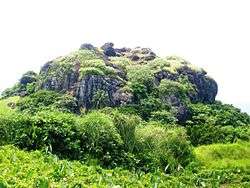Idjang
| Idjang Citadel | |
|---|---|
| Idjang | |
 Idjang in Savidug, Batanes Islands, Philippines. | |
.svg.png) | |
| Former names | Idjang , Moong , Kota |
| Alternative names | Batanes Castles |
| General information | |
| Status | National Cultural Treasure |
| Type | Traditional Ivatan people, Tagalogs |
| Architectural style | Filipino |
| Location | Batanes Islands |
| Town or city | Sabtang,Savidug |
| Country | Philippines |
| Coordinates | 20°20′00″N 121°31′52″E / 20.333331°N 121.531242°E |
| Elevation | Hilltop |
| Destroyed | Around 1790 CE |
| Height | 50–70cm (terraces) |
| Technical details | |
| Structural system | Fortress/ Citadel |
| Material | Limestone, Wood |
| Floor count | two -four [1] |
| Design and construction | |
| Architect | Various Ivatan Kings or Chieftains |
An Idjang or Batanes castle is a triangular-shaped hilltop citadel on the Batanes Islands in the Philippines, made from limestone and wood.
Background
In 1994, Dr. Eusebio Dizon, the Deputy director of the National Museum of the Philippines, went to Batanes with his team of experts for an archeological project. They discovered a triangular-shaped hill in Savidug, which is a municipality in Sabtang, These rocky formations are called Idjang by the locals.[2]
The ancestors of today's Ivatans descended from Austronesians who migrated to the islands 4000 years ago during the Neolithic period. They lived in fortified mountain areas called idjangs and drank sugar-cane wine, or palek. They also used gold as currency and produced a thriving agriculture-based industry. They were also seafarers and boat-builders.
Functions

The Ivatan people of the northern islands of Batanes often built fortifications to protect themselves during times of war. They built their so-called idjangs on hills and elevated areas.[2] These fortifications were likened to European castles because of their purpose. Usually, the only entrance to the castles would be via a rope ladder that would only be lowered for the villagers and could be kept away when invaders arrived.
During the colonial era
In 1783, the Spanish claimed Batanes as part of the Philippines under the auspices of Governor-General José Basco y Vargas. The Bashi Channel had come to be increasingly used by English East India Company ships and the Spanish authorities brought the islands under their direct administration to prevent them falling under British control.[3] However, the Ivatan remained on their idjangs, or mountain fortresses. In 1790, Governor Guerrero decreed that Ivatans were to leave their idjang and to live in the lowlands, thereby giving them more people to tax. Basco and Ivana were the first towns.[3]
See also
- Torogan
- Bahay Kubo
- Architecture of the Philippines
- Citadel
- Broch- An iron age Scottish round house structure.
- Cultural achievements of pre-colonial Philippines
- Culture of the Philippines
- Spanish Baroque architecture
References
- ↑ http://www.ironwulf.net/2015/08/24/batanes-savidug-idjang-exploring-the-ancient-dwellings-of-the-ivatans
- 1 2 "15 Most Intense Archaeological Discoveries in Philippine History". FilipiKnow. Retrieved 17 March 2015.
- 1 2 Howard T. Fry, "The Eastern Passage and Its Impact on Spanish Policy in the Philippines, 1758-1790", Philippine Studies, vol.33, First Quarter, 1985, pp.3-21, p.18.